It looks like you're using an Ad Blocker.
Please white-list or disable AboveTopSecret.com in your ad-blocking tool.
Thank you.
Some features of ATS will be disabled while you continue to use an ad-blocker.
share:
Originally posted by alfa1
Originally posted by abeverage
Anyone come up with any good explanation of this? To me an exposure is set and goes for how many seconds is requested and then a new image is created.
It is actually extraordinarily common in astronomical images to "stack" multiple frames on top of each other.
Actually more than normal, its standard practise.
No an exposure is an exposure sub exposure are not the same as Stacking. Stacking is taking several exposures light frames and dark frames and filters specific frames. Each is an individual exposure which is then used in a post effect creating an image. Multiple exposures can happen on an image agreed it is just with software like Registax or Astrostax it is faster and easier to do post process.
Originally posted by nataylor
reply to post by abeverage
I posted this information earlier in the thread, but the three exposures with the F606W filter were combined into a single data set. Similarly, the two exposures with the F814W filter were combined into a single data set. You can see that in the first two lines of the table here: archive.stsci.edu...
The F606W data set has an exposure time of 1320 seconds, which is 3 exposures of 440 seconds. The F814W data set has an exposure time of 980 seconds, which is 2 exposures of 490 seconds.
Ok, we are having some miscommunication here. I erroneously linked that data earlier and the images are not the same as on this page. or it is possible they were used in the 2 1320 and 980 exposures that doesn't matter.
Please show me the data for image below (hlsp_ison_hst_wfc3_130430_f606w-f814w_v1), it is not a multi-exposure image and still where some confusion is. I realize the curve is from the movement of the HST that was cleared up by you.
But what about the break up or dashes of light? Wouldn't a long exposure regardless of movement create a continuous blur of light?
This is the same image only with darkening the exposure. I am looking for a explanation in the drop of light in this image.
labeled hlsp_ison_hst_wfc3_130430_f606w-f814w_v1
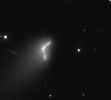
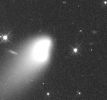
Or explain the double dashes in image labeled hlsp_ison_hst_wfc3_130430_f814w_v1
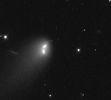
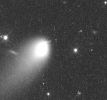
And for comparison This is the 1320 second exposure stacked image you referenced known as IC7I11010 Found here
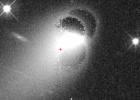
And this is the 980 exposure image known as IC7I11020 found here

You can tell those are multiple exposures because they (or the software) did a crappy stack overlay and you see ghosting...
Thank you.
edit on 20-8-2013 by abeverage because: grammatical and frustration lol
hlsp_ison_hst_wfc3_130430_f606w-f814w_v1 is a combination of all 5 exposures. (You can tell because it has both the F606W and F814W filters in the name, so it must contain exposures taken with both those filters). The reason it is not a continuous streak of light is that the 5 exposures totaling 2300 seconds (38 minutes and 20 seconds) was actually taken over a period of 48 minutes and 24 seconds. You can see that on the page I linked to above that the start and stop times for the observations were 3:35:43 and 4:24:07, which is a duration of 48 minutes nd 24 seconds. So there was a total of 10 minutes and 4 seconds where imaging wasn't occurring, which is why you have breaks in the streak of light in that image.
Originally posted by abeverage
Originally posted by nataylor
reply to post by abeverage
I posted this information earlier in the thread, but the three exposures with the F606W filter were combined into a single data set. Similarly, the two exposures with the F814W filter were combined into a single data set. You can see that in the first two lines of the table here: archive.stsci.edu...
The F606W data set has an exposure time of 1320 seconds, which is 3 exposures of 440 seconds. The F814W data set has an exposure time of 980 seconds, which is 2 exposures of 490 seconds.
Ok, we are having some miscommunication here. I erroneously linked that data earlier and the images are not the same as on this page. or it is possible they were used in the 2 1320 and 980 exposures that doesn't matter.
Please show me the data for image below (hlsp_ison_hst_wfc3_130430_f606w-f814w_v1), it is not a multi-exposure image and still where some confusion is. I realize the curve is from the movement of the HST that was cleared up by you.
But what about the break up or dashes of light? Wouldn't a long exposure regardless of movement create a continuous blur of light?
This is the same image only with darkening the exposure. I am looking for a explanation in the drop of light in this image.
labeled hlsp_ison_hst_wfc3_130430_f606w-f814w_v1

Or explain the double dashes in image labeled hlsp_ison_hst_wfc3_130430_f814w_v1

And for comparison This is the 1320 second exposure stacked image you referenced known as IC7I11010 Found here

And this is the 980 exposure image known as IC7I11020 found here

You can tell those are multiple exposures because they (or the software) did a crappy stack overlay and you see ghosting...
Thank you.edit on 20-8-2013 by abeverage because: grammatical and frustration lol
reply to post by nataylor
I'll ask again. Please link me to the data showing me the exposure times for lsp_ison_hst_wfc3_130430_f606w-f814w_v1
Thank you.
I'll ask again. Please link me to the data showing me the exposure times for lsp_ison_hst_wfc3_130430_f606w-f814w_v1
Thank you.
edit on 20-8-2013 by abeverage because: (no reason given)
Originally posted by abeverage
reply to post by nataylor
I'll ask again. Please link me to the data showing me the exposure times for lsp_ison_hst_wfc3_130430_f606w-f814w_v1
Thank you.edit on 20-8-2013 by abeverage because: (no reason given)
archive.stsci.edu...
The first two entires in that table show the observations made with the F606W and F814W filters.
If you look up proposal 13229, which contained all the ISON data taken on April 30th, you
can see if ISON-FIXED observations on page 5 you can see the alternating F606W and F814W filter exposures of 440 and 490 seconds total.There's even a
nice little timeline on that page that shows the overhead time between exposures.
Originally posted by nataylor
reply to post by abeverage
I posted this information earlier in the thread, but the three exposures with the F606W filter were combined into a single data set. Similarly, the two exposures with the F814W filter were combined into a single data set. You can see that in the first two lines of the table here: archive.stsci.edu...
The F606W data set has an exposure time of 1320 seconds, which is 3 exposures of 440 seconds. The F814W data set has an exposure time of 980 seconds, which is 2 exposures of 490 seconds.
We were discussing this comment,
(Update: An earlier version of this story referred to this representation of Comet ISON as a color image assembled from subsequent exposures. This was erroneous: although the background is in color, ISON itself is taken from only one exposure and is therefore monochromatic.)
hubblesite.org...
Why are they talking about only one exposure of ISON? Do they mean they only used one filter?
If this was already explained then I missed it.
Originally posted by nataylor
Originally posted by abeverage
reply to post by nataylor
I'll ask again. Please link me to the data showing me the exposure times for lsp_ison_hst_wfc3_130430_f606w-f814w_v1
Thank you.edit on 20-8-2013 by abeverage because: (no reason given)
archive.stsci.edu...
The first two entires in that table show the observations made with the F606W and F814W filters.
We are going slightly in circles here...
I am going to ask one more time please show me exposure times for lsp_ison_hst_wfc3_130430_f606w-f814w_v1
Isp_ison_hst_wfc3_130430_f606w-f814w_v1 is NOT all 5 exposures
The first 2 entries as you suggest are IC7I11010 and IC7I11020
The ones I posted
This is the 1320 second exposure stacked image you referenced known as IC7I11010 Found here

And this is the 980 exposure image known as IC7I11020 found here

These are composite images of these Photos
If like you are saying the 1st 2 data sets contain Isp_ison_hst_wfc3_130430_f606w-f814w_v1 and Data set IC7I11010 is 1320 seconds long or 22 minutes.
We can deduce that the image IC7I11010 is 22 minutes long comprised of 5, 4.4 minute exposure of which lsp_ison_hst_wfc3_130430_f606w-f814w_v1 is one.
Therefor lsp_ison_hst_wfc3_130430_f606w-f814w_v1 cannot be longer than 4.4 minutes as you suggested.
If you want stack the Photos and lsp_ison_hst_wfc3_130430_f606w-f814w_v1 and prove me wrong.
and I still have not been shown the exposure time for lsp_ison_hst_wfc3_130430_f606w-f814w_v1
As far as the F606W and F814W filters being used how do you know they were not used simultaneously?
Originally posted by nataylor
If you look up proposal 13229, which contained all the ISON data taken on April 30th, you can see if ISON-FIXED observations on page 5 you can see the alternating F606W and F814W filter exposures of 440 and 490 seconds total.There's even a nice little timeline on that page that shows the overhead time between exposures.
Right so you are incorrect and lsp_ison_hst_wfc3_130430_f606w-f814w_v1 is 440 seconds...
The reason it is not a continuous streak of light is that the 5 exposures totaling 2300 seconds
edit on 20-8-2013 by abeverage because: (no reason given)
Even by your naming logic lsp_ison_hst_wfc3_130430_f606w-f814w_v1 would only be 2 images using the F606W filter and the F814W filter amounting to 880 seconds.
edit on 20-8-2013 by abeverage because: (no reason given)
They're talking about the image on that page. This one:
Originally posted by NeoParadigm
Originally posted by nataylor
reply to post by abeverage
I posted this information earlier in the thread, but the three exposures with the F606W filter were combined into a single data set. Similarly, the two exposures with the F814W filter were combined into a single data set. You can see that in the first two lines of the table here: archive.stsci.edu...
The F606W data set has an exposure time of 1320 seconds, which is 3 exposures of 440 seconds. The F814W data set has an exposure time of 980 seconds, which is 2 exposures of 490 seconds.
We were discussing this comment,
(Update: An earlier version of this story referred to this representation of Comet ISON as a color image assembled from subsequent exposures. This was erroneous: although the background is in color, ISON itself is taken from only one exposure and is therefore monochromatic.)
hubblesite.org...
Why are they talking about only one exposure of ISON? Do they mean they only used one filter?
If this was already explained then I missed it.
That's a composite image where the stars are shown in color, by combining the exposure data with the various filters. The comet in that image is taken from only one of the 5 exposures taken.
Originally posted by nataylor
They're talking about the image on that page. This one:
Originally posted by NeoParadigm
Originally posted by nataylor
reply to post by abeverage
I posted this information earlier in the thread, but the three exposures with the F606W filter were combined into a single data set. Similarly, the two exposures with the F814W filter were combined into a single data set. You can see that in the first two lines of the table here: archive.stsci.edu...
The F606W data set has an exposure time of 1320 seconds, which is 3 exposures of 440 seconds. The F814W data set has an exposure time of 980 seconds, which is 2 exposures of 490 seconds.
We were discussing this comment,
(Update: An earlier version of this story referred to this representation of Comet ISON as a color image assembled from subsequent exposures. This was erroneous: although the background is in color, ISON itself is taken from only one exposure and is therefore monochromatic.)
hubblesite.org...
Why are they talking about only one exposure of ISON? Do they mean they only used one filter?
If this was already explained then I missed it.
That's a composite image where the stars are shown in color, by combining the exposure data with the various filters. The comet in that image is taken from only one of the 5 exposures taken.
That is a nice side tangent but the OP was discussing this image hla.stsci.edu...
In the OP thread...
www.abovetopsecret.com...
of which it is in the series we have been discussing please do not duck my line of questioning. I have been very clear and specific of what images I want information to.
I want to know why hlsp_ison_hst_wfc3_130430_f606w-f814w_v1 does not have a full streak. If you do not know admit you don't and let's move on.
edit on 20-8-2013 by abeverage because: (no reason given)
This is most likely a really ignorant question, I don't know squat about exposures and all that jazz..could someone please see if we could find A
DIFFERENT image of ANYTHING else out there that shows the same UFO look due to time delay and whatnot? Maybe that would help? PLEASE??!
reply to post by nataylor
Ok I see now.
Thank you.
Is astronomy a big hobby of yours or do you work in that field or something?
Just curious.
Ok I see now.
Thank you.
Is astronomy a big hobby of yours or do you work in that field or something?
Just curious.
Facts:
We live in a time where people seriously (still) believe in demons, the forum is full of it.
We can also assume that MANY people have not the slightest clue of retrograde motion and related science, and a lot of people have not even basic grasps of image exposures times and similar things.
Fact:
Some years ago a comet story featured on C2C caused some crazy people to kill themselves due to their lack of education, delusion and ignorance.
Fact:
NASA did a pretty poor job explaining the image since it took me multiple reads to understand that their aim with THAT image was actually to capture surrounding galaxies and stars, not so much to capture ISON's appearance.
Given the limited knowledge of many people and such lack of information...all it takes is some conspiracy preachers and nutcases...and you have a perfect receipt again for the next cult killing. Just saying.
We live in a time where people seriously (still) believe in demons, the forum is full of it.
We can also assume that MANY people have not the slightest clue of retrograde motion and related science, and a lot of people have not even basic grasps of image exposures times and similar things.
Fact:
Some years ago a comet story featured on C2C caused some crazy people to kill themselves due to their lack of education, delusion and ignorance.
Fact:
NASA did a pretty poor job explaining the image since it took me multiple reads to understand that their aim with THAT image was actually to capture surrounding galaxies and stars, not so much to capture ISON's appearance.
Given the limited knowledge of many people and such lack of information...all it takes is some conspiracy preachers and nutcases...and you have a perfect receipt again for the next cult killing. Just saying.
edit on 20-8-2013 by NoRulesAllowed because: (no reason given)
HST Filters
Sorry I missed this NeoParadigm if you look the Comet is not in color but the stars are. They got the composite for the stars through multiple exposures using a Red, Green and Blue filters. But ISON is just one exposure (no color).
In other words they take a photo with only the Red channel turned on and only red light comes through, then green and then blue. They will also take a black or a myriad of filters depending on the process of what they want to capture. When they combine them (stack them) you get a nice color image. But for whatever reason they decided not to do that with ISON...I think because they got really bad ghosting (multiple images) due to bad tracking.
Does that help?
p.s. the F814W refers to the filter (F) 814 (mid-Infrared or infrared basically Red) Wavelength (W)
Hubble Filters
Originally posted by NeoParadigm
Originally posted by nataylor
reply to post by abeverage
I posted this information earlier in the thread, but the three exposures with the F606W filter were combined into a single data set. Similarly, the two exposures with the F814W filter were combined into a single data set. You can see that in the first two lines of the table here: archive.stsci.edu...
The F606W data set has an exposure time of 1320 seconds, which is 3 exposures of 440 seconds. The F814W data set has an exposure time of 980 seconds, which is 2 exposures of 490 seconds.
We were discussing this comment,
(Update: An earlier version of this story referred to this representation of Comet ISON as a color image assembled from subsequent exposures. This was erroneous: although the background is in color, ISON itself is taken from only one exposure and is therefore monochromatic.)
hubblesite.org...
Why are they talking about only one exposure of ISON? Do they mean they only used one filter?
If this was already explained then I missed it.
Sorry I missed this NeoParadigm if you look the Comet is not in color but the stars are. They got the composite for the stars through multiple exposures using a Red, Green and Blue filters. But ISON is just one exposure (no color).
In other words they take a photo with only the Red channel turned on and only red light comes through, then green and then blue. They will also take a black or a myriad of filters depending on the process of what they want to capture. When they combine them (stack them) you get a nice color image. But for whatever reason they decided not to do that with ISON...I think because they got really bad ghosting (multiple images) due to bad tracking.
Does that help?
p.s. the F814W refers to the filter (F) 814 (mid-Infrared or infrared basically Red) Wavelength (W)
Hubble Filters
edit on 20-8-2013 by abeverage because:
clarifications
Originally posted by abeverage
Even by your naming logic lsp_ison_hst_wfc3_130430_f606w-f814w_v1 would only be 2 images using the F606W filter and the F814W filter amounting to 880 seconds.edit on 20-8-2013 by abeverage because: (no reason given)
Sigh. No.
Let's go over how the images are captured. A scientist submits a proposal (in this case, it's [url=http://www.stsci.edu/hst/phase2-public/13229.pdf]proposal 13229), outlining what they want to image, and when and how they want to image it. As you can see that proposal is from April 23. For the fixed-star background (which it calls ISON-FIXED), it calls for a total of 5 exposures, in this order: 440 seconds with the F606W filter, then 490 seconds with the F814W filter, then 440 seconds with the F606W filter, then 490 seconds with the F814W filter, then a final 440 seconds with the F606W filter.
So that proposal was approved and the observations were scheduled for April 30.
Using the Space Telescope Institute's web site, we can look up all the observations for a given proposal. If we look up proposal 13229, we get this listing: archive.stsci.edu...
We only care about the first two entires on that page (the ones marked ISON-FIXED). Each combination of exposures with one filter is combined into one dataset. The last column in that table is called "High Level Science Products." For the first entry, with the F606W filter, there are 5 products. If you click on the 5 you get this page: archive.stsci.edu...
This page contains all the science products that come from observations in that dataset. The bottom three entries are files that contain the first, second, and third exposures with the F606W filter (they're labeled hlsp_ison_hst_wfc3_130430a_f606w_v1_sci.fits, hlsp_ison_hst_wfc3_130430c_f606w_v1_sci.fits, and hlsp_ison_hst_wfc3_130430e_f606w_v1_sci.fits). Note the "a" "c" and "e" in their names. This is because these are the first, third, and fifth exposures taken, as outlined in the 13229 proposal. Then you have hlsp_ison_hst_wfc3_130430_f606w_v1_comb.fits file. The "comb" stands for "combined." That's all three of the F606W exposures combined into one file. Then you have the hlsp_ison_hst_wfc3_130430_f606w-f814w_v1_comb.fits. Again, the "comb" stands for combined. This file contains ALL five of the exposures, the 3 with the F606W filter and the two with the F814W filter.
If we go back to this page: archive.stsci.edu... we see that there are 4 High Level Science Products for the F814W filter. Clicking on that number we get this page: archive.stsci.edu...
On this page, the bottom two entries are the two exposures with the F814W filter (labeled hlsp_ison_hst_wfc3_130430b_f814w_v1_sci.fits and hlsp_ison_hst_wfc3_130430d_f814w_v1_sci.fits). Note the "b" and "d" in their names. That's because these are the second and forth exposures, as outlined in proposal 13229. The next entry up is hlsp_ison_hst_wfc3_130430_f814w_v1_comb.fits . Again, this name indicates it is a combined file, containing both the exposures with the F814W filter. Then we have the hlsp_ison_hst_wfc3_130430_f606w-f814w_v1_comb.fits. This is the same file as found on the F606W filter High Level Science Products page (download them and compare the files if you don't believe me). Again, this file contains all 5 of the exposures taken.
Continued...
If you'd like to look at this visually, you can. This page, which you linked to before, contains all of these High Level Science Products: archive.stsci.edu...
We're looking at the images released on July 16, so ignore the top row of pictures. Under July 16, the first image is hlsp_ison_hst_wfc3_130430a_f606w_v1. Note the name. This is exposure "a", taken with the F606W filter. If You click on the Interactive Display, zoom in, and darken it, you will see it contains one streak of light. That's because it is a single exposure. The next image on that page, hlsp_ison_hst_wfc3_130430b_f814w_v1, also shows a single streak. The next image, hlsp_ison_hst_wfc3_130430c_f606w_v1, again shows a single streak. And again, the next image, hlsp_ison_hst_wfc3_130430d_f814w_v1, is a single streak. And finally, hlsp_ison_hst_wfc3_130430e_f606w_v1, is a single streak. So you've just looked at the "a" "b" "c" "d" and "e" individual exposures. The next image on that page, hlsp_ison_hst_wfc3_130430_f606w_v1, shows three streaks. This is because it is a combination of all three exposures with the F606W filter. The next image on the page, hlsp_ison_hst_wfc3_130430_f814w_v1, shows two streaks because it is a combination of the two exposures taken with the F814W filter. The final image on that page, hlsp_ison_hst_wfc3_130430_f606w-f814w_v1 shows 5 streaks, because it is a combination of all 5 exposures.
Hope this helps explain it.
If you'd like to look at this visually, you can. This page, which you linked to before, contains all of these High Level Science Products: archive.stsci.edu...
We're looking at the images released on July 16, so ignore the top row of pictures. Under July 16, the first image is hlsp_ison_hst_wfc3_130430a_f606w_v1. Note the name. This is exposure "a", taken with the F606W filter. If You click on the Interactive Display, zoom in, and darken it, you will see it contains one streak of light. That's because it is a single exposure. The next image on that page, hlsp_ison_hst_wfc3_130430b_f814w_v1, also shows a single streak. The next image, hlsp_ison_hst_wfc3_130430c_f606w_v1, again shows a single streak. And again, the next image, hlsp_ison_hst_wfc3_130430d_f814w_v1, is a single streak. And finally, hlsp_ison_hst_wfc3_130430e_f606w_v1, is a single streak. So you've just looked at the "a" "b" "c" "d" and "e" individual exposures. The next image on that page, hlsp_ison_hst_wfc3_130430_f606w_v1, shows three streaks. This is because it is a combination of all three exposures with the F606W filter. The next image on the page, hlsp_ison_hst_wfc3_130430_f814w_v1, shows two streaks because it is a combination of the two exposures taken with the F814W filter. The final image on that page, hlsp_ison_hst_wfc3_130430_f606w-f814w_v1 shows 5 streaks, because it is a combination of all 5 exposures.
Hope this helps explain it.
reply to post by abeverage
Thanks, but just to be clear, the pic they are talking about here,
is not the same pic that is in the OP that we have been discussing?
Thanks, but just to be clear, the pic they are talking about here,
(Update: An earlier version of this story referred to this representation of Comet ISON as a color image assembled from subsequent exposures. This was erroneous: although the background is in color, ISON itself is taken from only one exposure and is therefore monochromatic.)
is not the same pic that is in the OP that we have been discussing?
reply to post by nataylor
So ntaylor how long was the exposure to lsp_ison_hst_wfc3_130430_f606w-f814w_v1?
So ntaylor how long was the exposure to lsp_ison_hst_wfc3_130430_f606w-f814w_v1?
It's a total of 2300 seconds (three exposures of 440 seconds with the F606W filter and two exposures of 490 seconds with the F814W filter).
Originally posted by abeverage
reply to post by nataylor
So ntaylor how long was the exposure to lsp_ison_hst_wfc3_130430_f606w-f814w_v1?
new topics
-
Sorry to disappoint you but...
US Political Madness: 33 minutes ago -
Watch as a 12 million years old Crab Emerges from a Rock
Ancient & Lost Civilizations: 5 hours ago -
ILLUMINATION: Dimensions / Degrees – Da Vincis Last Supper And The Philosophers Stone
Secret Societies: 11 hours ago
top topics
-
Speaking of Pandemics
General Conspiracies: 14 hours ago, 9 flags -
ILLUMINATION: Dimensions / Degrees – Da Vincis Last Supper And The Philosophers Stone
Secret Societies: 11 hours ago, 9 flags -
Watch as a 12 million years old Crab Emerges from a Rock
Ancient & Lost Civilizations: 5 hours ago, 9 flags -
Just Sick of It! Done! Can't take it anymore!
General Chit Chat: 12 hours ago, 8 flags -
Stuck Farmer And His Queue Jumping Spawn
Rant: 14 hours ago, 4 flags -
Sorry to disappoint you but...
US Political Madness: 33 minutes ago, 4 flags
active topics
-
Sorry to disappoint you but...
US Political Madness • 2 • : 38181 -
Joe Biden gives the USA's Highest Civilian Honor Award to Hillary Clinton and George Soros.
US Political Madness • 41 • : Flyingclaydisk -
Just Sick of It! Done! Can't take it anymore!
General Chit Chat • 14 • : Flyingclaydisk -
What Is 'Quad Demic'? Mask Mandate Returns In These US States
Diseases and Pandemics • 38 • : NorthOS -
Musk calls on King Charles III to dissolve Parliament over Oldham sex grooming gangs
Mainstream News • 176 • : cherokeetroy -
Winter Storm
Fragile Earth • 32 • : Irishhaf -
Vehicle Strikes people in New Orleans
Mainstream News • 300 • : Oldcarpy2 -
DONALD J. TRUMP - TIME's Most Extraordinary Person of the Year 2024.
Mainstream News • 61 • : Oldcarpy2 -
Candidate Harris Supporter MARK CUBAN Says Trump Has No Smart-Intelligent Women in His Orbit.
2024 Elections • 88 • : Oldcarpy2 -
Matthew Livelsberger said he was being followed by FBI
Political Conspiracies • 72 • : WeMustCare

